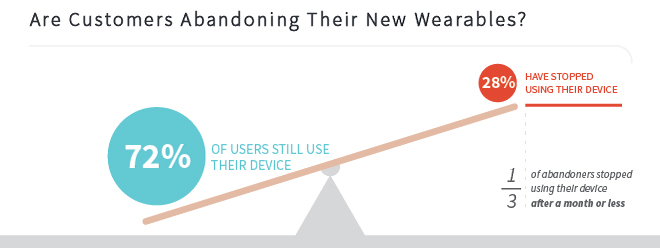Do Fitness Trackers Struggle With Abandonment?
There is nothing more sinister to the success of a new tech product than the dreaded “abandonment rate”. Whenever a cutting edge tech product launches, there’s a flood of early adopters who are interested in being the first consumers to own and use the product. Despite high levels of enthusiasm from these early adopters, a significant portion of them often end up “abandoning” their new devices shortly after their purchase
During our fitness trackers Betabound survey we looked at how 2,000 members of our Betabound community use their fitness trackers and how many of them have abandoned their new wearables. According to the results, the answer is not very many.

Of everyone surveyed, 72% said they are currently using their fitness trackers months or years after their initial purchase. Just 28% testers answered they had stopped using their fitness trackers at some point, with one third of that group abandoning their fitness tracker devices within the first month of purchasing.
The reasons for abandonment varied greatly. Problems with battery life topped the list at 12%, closely following by another 12% of testers stopped because of a broken device. Not being useful or failing to keep users engaged came in at a very low 7% and 6%, respectively.
Despite the different reasons testers might have stopped using their fitness trackers, a whopping 71% returned to using their device again. Only 29% of initial abandoners, or 8% of the everyone, stopped using their fitness trackers for good.
For a growing tech sector (that’s been accused of being a fad more than once) there is a case to made that wearable tech is showing staying power. The data suggests that customers are not only using their fitness wearables, but are also making them part of their everyday routine.
For wearables, a product’s ability to become integrated into the daily lives of its users will ultimately decide the future of this technology. As early adopters become accustomed to using wearables, they also learn to depend on them. As that dependency increases, wearable technology becomes more likely to permanently establish itself within the marketplace.
The promise of existing wearable technology only grows when considering what the devices of today could mean for the future. As health and fitness devices continue to evolve, next generation models could have a profound impact on how their users live their lives. Similar to how the smartphone changed the way people communicate and share information, wearable tech has the same disruptive ability to modern life.
It’s not a leap to think the demand for fitness wearables will only increase as more people discover wearables, and build their lives around their favorite devices and the information they provide. As fitness trackers continue to improve and offer additional features, they will increasingly appeal to more tech consumers. Eventually more wearables, like health and fitness trackers, will become integrated into the average American’s everyday life. When that day comes, our world could be better off because of it.
See the full results from our survey check out our infographic by clicking here!
Join Betabound so you don’t miss our upcoming community surveys!